unmanned
Latest
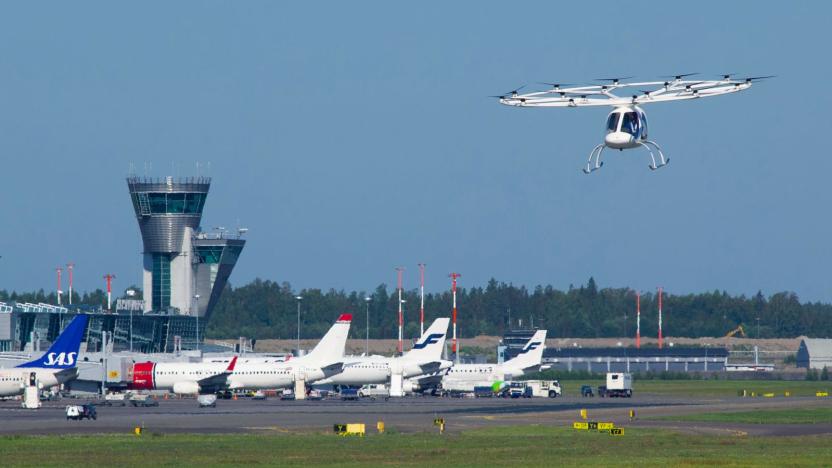
Volocopter proves its air taxi can work with air traffic control
In order for air taxis and delivery drones to succeed, they'll have to play nicely with air traffic control systems. Yesterday, a Volocopter air taxi proved it's ready to do just that. The Volocopter 2X performed a series of tests at the Helsinki international airport, where it demonstrated its ability to integrate with both manned and unmanned air traffic management systems.
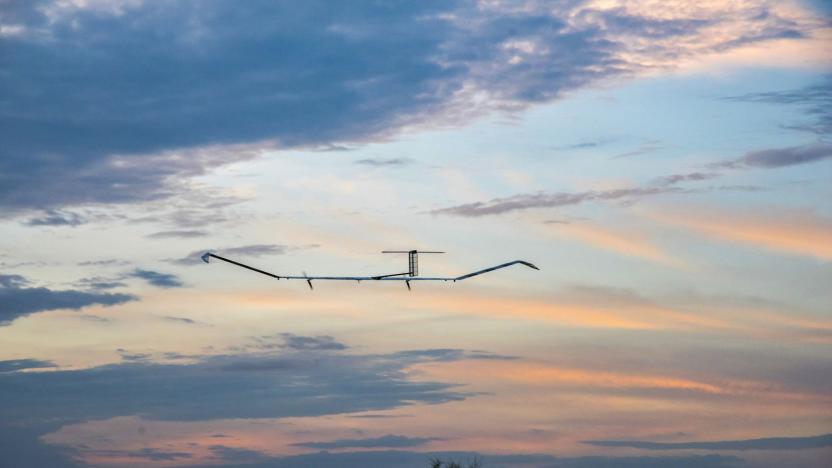
Solar-powered aircraft stays aloft for record-breaking 25 days
While Facebook and Google recently pulled the plug on their solar-powered internet drones, another company with a lot more experience is having success with the idea. Airbus announced that its solar-powered Zephyr S HAPS (high altitude pseudo-satellite) flew for 25 straight days, setting a time aloft record for any airplane, ever. It shattered the previous record of 14 days, marked by a previous prototype Zephyr aircraft.
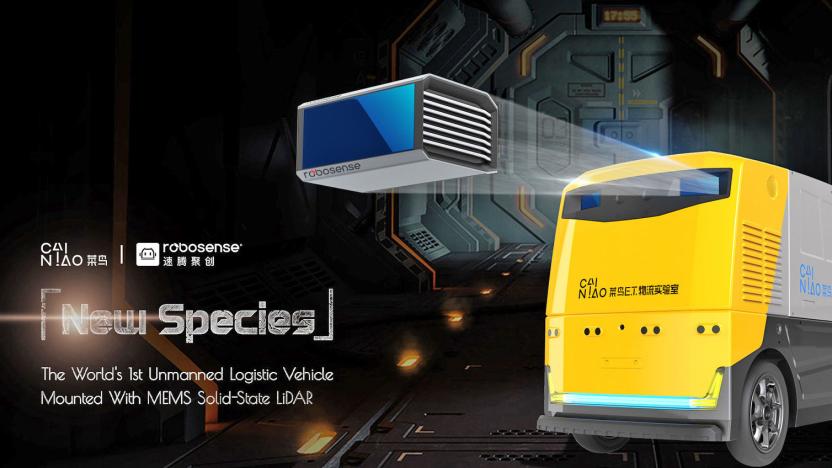
Alibaba’s new autonomous robot delivers packages at a modest pace
Unlike its car vending machine concept, Alibaba's ideas for robots have been more mundane and mainly confined to warehouses (the same kind that Amazon uses). But today, the Chinese ecommerce titan introduced a package-delivering 'bot that uses LiDAR to navigate around. The package locker it carries uses facial recognition to ensure it's got the right recipient before popping open its doors.
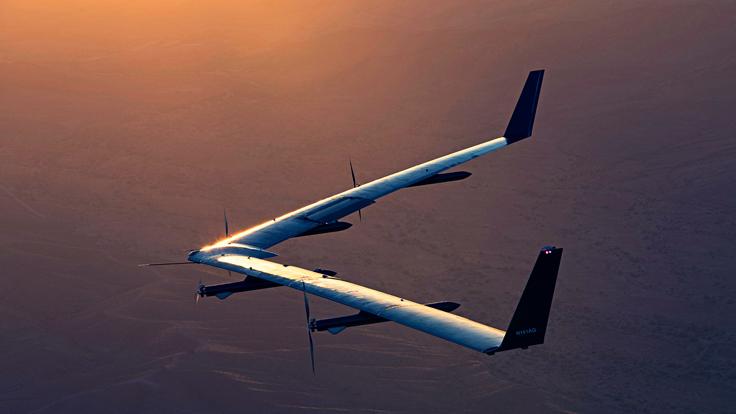
Facebook successfully lands its Aquila drone for the first time
Facebook has been testing its solar-powered unmanned aircraft, Aquila, for the past couple of years. The internet-providing drone made its first full flight last June, though it crashed on landing after the 96-minute flight in Yuma, Arizona. The accident prompted a US investigation, which found that the autonomous plane went down due to windy conditions. The second full flight, just announced by Facebook, took place on May 22, ran for one hour and 46 minutes and landed successfully.

Japan's space junk collection experiment ends in failure
Well that's disappointing. On January 27th, Japan's space agency (JAXA) successfully launched the Kounotori 6 spacecraft to the ISS. It was supposed to test a novel method of dragging space debris out of orbit however a technical issue prevented the spacecraft from carrying out that test before its fiery death in Earth's atmosphere on Monday morning.

DARPA's reusable unmanned 'gremlin' planes are a go
Four aerospace and security corporations will attempt to make DARPA's "gremlins program" dream a reality. The Department of Defense division has joined forces with its frequent collaborator Lockheed Martin, Dynetics of Alabama, as well as Composite Engineering and General Atomics Aeronautical Systems of California. Dan Patt, the program manager, said these four contractors are "exploring different, innovative approaches" to create a system of reusable unmanned vehicles (called gremlins) that can launch from bigger aircraft, such as bombers and cargo planes.

Air Force's mysterious space drone returns after two years in orbit
Following its longest-ever mission by far, the 11,000 pound X-37B unmanned spacecraft has returned to Earth bearing... well, we don't actually know. You see, after NASA and Boeing developed the craft (about a fifth the size of the Space Shuttle), it bounced over to the Air Force, which is using it for top-secret missions. The X-37B's longest previous flight lasted about 15 months, and this time, it stayed in orbit just shy of two years. As for what it was doing up there, exactly, cue the speculation. Some experts think it was launching spy gear from the pickup-bed-sized payload bay, while others believe it was designed to capture or impair enemy satellites. The Air Force denies all that, saying it was just testing space tech like advanced guidance, robotic systems and autonomous orbital flight. It certainly nailed the latter -- with no human at the controls, the X-37B made a perfect touchdown following a 218 mile-high descent. To see it, check the all-too-brief video below. [Image credit: Boeing]

Watch the US Navy's swarm of robotic boats take to the sea
Overwhelming numbers can help win a sea battle, but sailors are far too valuable to simply throw away -- and the US Navy knows it. To that end, it recently tested a swarm of robotic gunboats that work in tandem to either protect a main warship or surround the enemy. As you can see in the video below, they're very well coordinated. The vehicles' Control Architecture for Robotic Agent Command and Sensing (CARACaS) lets them both operate independently while sharing their paths and radar data with each other, keeping them both out of each others' way and aware of any potential threats.
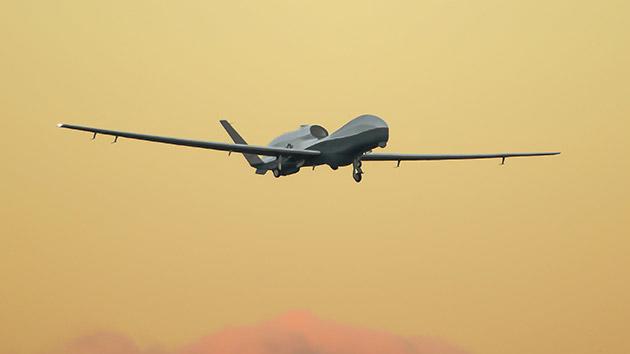
US Navy's Triton UAV completes initial flight testing
One of Northrop Grumman's new war/spy gadgets, the Triton unmanned aerial vehicle, just got closer to joining the US Navy's reconnaissance fleet. After almost two years since the defense tech company announced the aircraft, the Triton has finally completed its initial test flight program and has now been cleared to fly at various altitudes, speeds and weights. The tests, which kicked off in May 2013, spanned 13 flights (including long-endurance ones) with a total of 81 hours flown at altitudes up to 59,950 feet. To put that in perspective, commercial airplanes usually fly at around 35,000 feet in the air. While the company and the Navy successfully got through this phase, they still have to tackle more tests before the Triton goes into service sometime in 2017. They're currently preparing to equip two Tritons with sensor systems designed to take high-res images, detect targets with radar and provide a means of communication between military units over long distances. These UAVs will take to the air this June or July to determine whether the sensors work as intended. In the future, the Navy plans to build 68 Tritons specifically to work with manned P-8 Poseidon patrol planes. If the latter sounds familiar, it's because a deployed P-8 unit is currently involved in the search for the missing Malaysian Airlines flight MH370. When the Triton's ready for primetime, it could considerably extend the P-8's search range, making it better equipped to handle similar missions.

SpaceX to start International Space Station cargo runs on October 7th, kick off routine private spaceflight
SpaceX just put a date on when private space travel becomes a seemingly everyday affair: October 7th. That's when the company and NASA expect to launch a Falcon 9 rocket from Cape Canaveral Air Force Station delivering the first of a dozen cargo loads to the International Space Station through the unmanned Dragon spacecraft. While we're not expecting any trouble -- SpaceX has done this before -- there's a chance for a rescheduled launch on October 8th if there are any minor setbacks. The flights won't achieve the cachet of government-funded runs with human beings onboard, but we're sure the company doesn't mind when it's taking steps towards democratizing spaceflight... and pocketing $1.6 billion in the process.

Army seeking proposals for casualty-carrying UAVs
Combat is a grizzly business, and despite the best efforts of medical evacuation crews, it's not always feasible to send rescue teams into the fray. The US Army is seeking to address this with "autonomous vertical takeoff and landing (VTOL) unmanned aircraft systems (UAS)" (read: drones) for dropping off medical supplies and picking up injured troops. In its latest request for research and development proposals, the Army calls not for new tools, but for the repurposing of current aircraft to do the job. Preferred candidates in the already unmanned class include the A160 Hummingbird and the K-MAX, while one of the suggestions for remote-control modification is the infamous Black Hawk. Makes the AR.Drone seem a little wimpy, doesn't it?

BAE Systems speaks about unmanned ASTRAEA: no reason it can't stay in air 'for weeks'
BAE Systems' ASTRAEA isn't a new concept -- the company's been playing up its unmanned potential for quite some time now -- but it's all seeming entirely less pie-in-the-sky now that the Farnborough Airshow has kicked off. Typically, UAVs are thought to be smaller, drone-type apparatuses; these things are typically used in military exercises where remote gunfire or reconnaissance is required. Clearly, it's about time someone asked the obvious: "Why?" Lambert Dopping-Hepenstal, Engineering Director Systems and Strategy, Military Air and Information at BAE and ASTRAEA Program Director recently spoke at the aforesaid event, noting that this particular aircraft could "open up a new market." He continued: "Current search and rescue aircraft are limited by human endurance, however with a UAV there's no reason why they can't stay up for weeks." Sadly, he also affirmed that there aren't any plans to ship actual humans up in the air without a pilot onboard, but if you're rich and mettlesome enough to pull it off yourself... well, be sure to send us the video. Also, Godspeed.

X-37B finally touches down, completing its not-so-secret classified mission (video)
After more than a year of circling the globe, the US Air Force's X-37B has finally touched down at Vandenberg Air Force Base in California. The unmanned, reusable space plane spent 469 days in orbit, performing a number of experiments (many of which are classified) before finally ending its lengthy run Saturday. What exactly the military has learned from the extended orbital excursion is unclear, but, like the Mars rovers before it, the X-37B turned out to be far more robust than many had anticipated. Its mission was originally intended to last just nine months, but its operators managed to milk about six more months out of the craft. While we wait to find out what the next step is, enjoy the video of it landing after the break.

Solair Altius unmanned aerial vehicle, eyes-on (video)
It could just be us, but we tend to dwell on some fairly negative connotations when we hear the phrase "unmanned aerial vehicle" -- after all, the lion's share of media attention devoted to devices in that category tend to focus on military applications. Not surprisingly, the creators of the Solair Altius being strung from the rafters of the Artistan's Asylum hackerspace in Somerville, Massachusetts has far more peaceful intentions when they developed the plane.%Gallery-158272%

Happy Biiiirthday Mr. USAF X-37B Robot Space Plane
The X-37B was only meant to stay up in space for a gestational nine months, but a full year has now passed since launch and the US Air Force apparently has little interest in bringing its baby home. On the contrary: according to Space.com, the plan is to send up another unmanned space plane to keep the X-37B company on its [CLASSIFIED] missions. Whatever it's getting up to in that airless playground, it must be doing something right. Air Force Lt. Col. Tom McIntyre says the craft is "setting the standard for a reusable space plane and, on this one-year orbital milestone, has returned great value on the experimental investment." Which is a fine way of saying [STILL CLASSIFIED].

DIY unmanned airship soars 95,000 feet above Earth, lays claim to new record (video)
Are you entertaining dreams of launching your own private spacecraft? All you need is about 30 grand in your bank account, and lots of spare time. Last weekend, a company called JP Aerospace sent its unmanned Tandem airship 95,085 feet above the ground -- a height that, according to the company, establishes a new record for remotely controlled airships. In fact, JP Aerospace says this altitude is a full four miles higher than any other airship has ever flown. To pull this off, the team strapped its 30-foot-long aircraft with two balloons, and packed it with a pair of electric motors that manipulated the Tandem's specially designed propellers. It's a relatively simple method, and one that didn't exactly break the bank, either. All told, it took about five years and some $30,000 to launch the aircraft, as part of the company's Airship to Orbit project. The long-term goal is to use the Tandem or similar airships as a launch pad for rockets or other interstellar aircraft. No word yet on when that could happen, but you can float past the break for a brief video on the Tandem, coupled with a brief PR.

K-MAX unmanned chopper delivers Air Force salute to Afghan danger (video)
It's a year since Lockheed Martin won the contract to provide an unmanned cargo delivery system to the US military and now its first K-MAX helicopter is just about ready for duty. The 6,000-pound RC chopper is scheduled to journey to the manifold fronts of Afghanistan next month, where it'll get busy ferrying its own bodyweight in ammo and supplies to needy anthills up to 200km away. And, if things get too sticky for laptop flying, there's always room for a brave soul to jump in there and grab the controls. You'll find a fresh demo video after the break, plus we've also stuck in that fancy clip from last year to rotor your memory.

Amazon CEO's flying water tank crashes, leaves dent in his space travel dream
In a moment of profound candidness, Amazon billionaire Jeff Bezos has revealed that the mid-air failure of his unmanned spaceship 11 days ago was "not the outcome any of us wanted." The searing truth of his statement is certainly borne out by the fact that NASA has poured millions of dollars of funding into Bezos's space company, Blue Origin, in the hope that it will one day ferry people to the ISS and replace the scuttled shuttle program. Indeed, Blue Origin's latest craft looked every inch a shuttle-beater until it suddenly went berserk at 45,000 feet, forcing the Asimovian onboard computer to cut power and nose dive into the ground in an effort to avoid civilian casualties. Not an ideal result, to be sure, but Jeff is hardly likely to give up on his starry ambitions -- everybody knows he has a thing for thrusters.

Scaled Composites and Northrop Grumman's new Firebird spy plane: pilot optional
Scaled Composites is best known for creating commercial spaceships for Sir Richard Branson, but it turns out the firm can construct more conventional flying machines, too. The company has joined forces with Northrop Grumman to build the Firebird, a flexible new plane that's a veritable surveillance Swiss Army knife. Part Predator UAV and part traditional aircraft, the Firebird can take to the skies with or without a human at the controls as it combs the earth for enemies of the state. What's more, the airframe's HD video and infrared cameras, radar, and communications gear in the fuselage are able to gather info simultaneously to find the bad guys, and those payloads are easily swapped for other equipment through a universal interface. It's scheduled to strut its intelligence-gathering stuff during a military exercise in a couple weeks, and if all goes according to plan, it'll become another terrorist tracking tool in the U.S. arsenal. Video of the brand new bird in action is after the break.

Boeing's Phantom Ray soars like a terrifying, unmanned eagle
Boeing's new Phantom Ray aircraft made a covert first flight last week, taking to the skies above California's Edwards Air Force Base. The unmanned airborne system (UAS) reached 7,500 feet, hitting a maximum speed of 178 knots and flying for a total of 17 minutes -- sure, it won't outlast the Phantom Eye anytime soon, but hey, we've all gotta start somewhere. What the 36-foot long vehicle lacks in relative endurance, it makes up stealth, designed to be undetectable on radar, and thanks to a deeply embedded engine, giving off a minimal amount of heat. Boeing will be running additional tests on the autonomous vehicle in the coming weeks, in attempt to prep it for possible future surveillance and attack missions. No word on when this might actually be hitting an airspace near you, but in the meantime, it's probably best to refrain from ticking off any deep pocketed governments.














